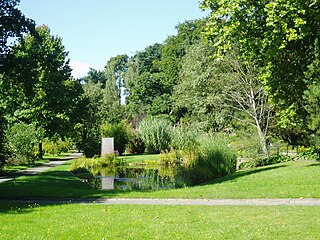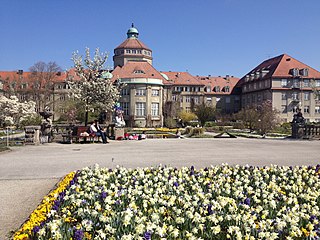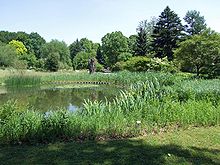

The Botanischer Garten der Johann Wolfgang Goethe-Universität Frankfurt am Main (7 hectares), also known as the Botanischer Garten Frankfurt am Main, is a botanical garden and arboretum maintained by the Goethe University. It is located at Siesmayerstraße 72, Frankfurt am Main, Germany, and opens daily in the warmer months.
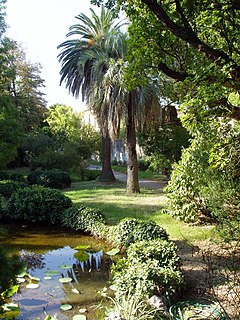
A botanical garden or botanic garden is a garden dedicated to the collection, cultivation, preservation and display of a wide range of plants labelled with their botanical names. It may contain specialist plant collections such as cacti and other succulent plants, herb gardens, plants from particular parts of the world, and so on; there may be greenhouses, shadehouses, again with special collections such as tropical plants, alpine plants, or other exotic plants. Visitor services at a botanical garden might include tours, educational displays, art exhibitions, book rooms, open-air theatrical and musical performances, and other entertainment.

An arboretum in a general sense is a botanical collection composed exclusively of trees. More commonly a modern arboretum is a botanical garden containing living collections of woody plants and is intended at least in part for scientific study.

Germany, officially the Federal Republic of Germany, is a country in Central and Western Europe, lying between the Baltic and North Seas to the north, and the Alps to the south. It borders Denmark to the north, Poland and the Czech Republic to the east, Austria and Switzerland to the south, France to the southwest, and Luxembourg, Belgium and the Netherlands to the west.
First Garden: near the Eschenheimer Tor (1767-1907). Frankfurt's first botanical garden was created in the years 1763-1774 by Johann Christian Senckenberg (1707-1772), and was operated by the Senckenberg Foundation as a hortus medicus for the cultivation of medicinal herbs for the foundation's public hospital and medical institute. Its site, about 1 hectare in size, was patterned on Carl Linnaeus' garden in Uppsala. Until 1867 every director was a physician. By 1903, the garden cultivated more than 4,000 species but its extent had been gradually reduced by hospital expansion until just 7,000 m² remained.
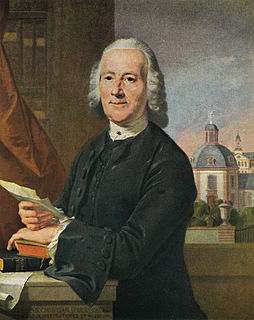
Johann Christian Senckenberg was a German physician, naturalist and collector.
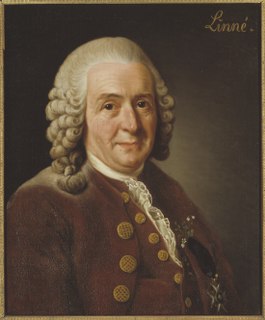
Carl Linnaeus, also known after his ennoblement as Carl von Linné, was a Swedish botanist, physician, and zoologist who formalised binomial nomenclature, the modern system of naming organisms. He is known as the "father of modern taxonomy". Many of his writings were in Latin, and his name is rendered in Latin as Carolus Linnæus.

Uppsala is the capital of Uppsala County and the fourth-largest city in Sweden, after Stockholm, Gothenburg, and Malmö. It had 168,096 inhabitants in 2017.
Second Garden: adjacent to the Palmengarten (1907-1958). After lengthy negotiations between the city and foundation, a new, 1.4-hectare site was found just east of the Palmengarten. The move took place in 1907-1908. When the university was founded in 1914, the garden became a research facility. In the 1930s it was improved by an arboretum, alpine garden, and sand dunes. (The Palmengarten was restored in the 1960s and serves as Frankfurt's other major botanical garden.)
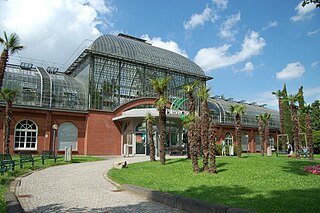
The Palmengarten is one of three botanical gardens in Frankfurt am Main, Germany. It is located in the Westend-Süd district. It covers a surface of 22 hectares.

An alpine garden is a domestic or botanical garden specialising in the collection and cultivation of alpine plants growing naturally at high altitudes around the world, such as in the Caucasus, Pyrenees, Rocky Mountains, Alps, Himalayas and Andes.
Third Garden: Siesmayerstraße (since 1931). From 1931-1937, the garden again began relocation to today's site on Siesmayerstraße in the northwestern Grüneburgpark. This move was delayed by World War II and the subsequent American occupation, and relocation was finally completed in 1958. A laboratory building and large greenhouse were added in the years 1961-63.
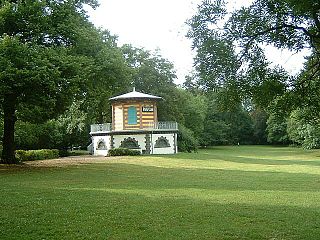
The Grüneburgpark is a park in the Westend district of Frankfurt, whose name derives from the "Green castle", which stood on the site in the 14th century. In 1789 the banker Peter Heinrich von Bethmann Metzler acquired the property and designed the park. In the following years the great thinkers of the day met here, among them Johann Wolfgang von Goethe and Bettina von Arnim.

World War II, also known as the Second World War, was a global war that lasted from 1939 to 1945. The vast majority of the world's countries—including all the great powers—eventually formed two opposing military alliances: the Allies and the Axis. A state of total war emerged, directly involving more than 100 million people from over 30 countries. The major participants threw their entire economic, industrial, and scientific capabilities behind the war effort, blurring the distinction between civilian and military resources. World War II was the deadliest conflict in human history, marked by 50 to 85 million fatalities, most of whom were civilians in the Soviet Union and China. It included massacres, the genocide of the Holocaust, strategic bombing, premeditated death from starvation and disease, and the only use of nuclear weapons in war.
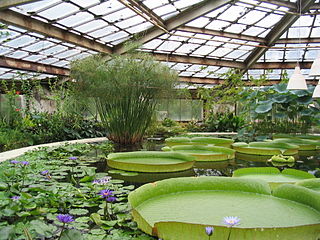
A greenhouse is a structure with walls and roof made chiefly of transparent material, such as glass, in which plants requiring regulated climatic conditions are grown. These structures range in size from small sheds to industrial-sized buildings. A miniature greenhouse is known as a cold frame. The interior of a greenhouse exposed to sunlight becomes significantly warmer than the external ambient temperature, protecting its contents in cold weather.
Today the garden contains about 5,000 species, with special collections of Rubus (45 species) and indigenous plants of central Europe. It is organized into two major areas as follows. The geobotanical area contains an alpine garden, arboretum, meadows, steppes, marsh, and pond, as well as collections of plants from the Canary Islands, Caucasus, East Asia, Mediterranean, and North America. The systematic and ecological collection includes crop plants, endangered species, ornamental plants, roses, and the Neuer Senckenbergischer Arzneipflanzengarten (New Senckenberg Medicinal Plant Garden, 1200 m²).
In biology, a species ( ) is the basic unit of classification and a taxonomic rank of an organism, as well as a unit of biodiversity. A species is often defined as the largest group of organisms in which any two individuals of the appropriate sexes or mating types can produce fertile offspring, typically by sexual reproduction. Other ways of defining species include their karyotype, DNA sequence, morphology, behaviour or ecological niche. In addition, paleontologists use the concept of the chronospecies since fossil reproduction cannot be examined. While these definitions may seem adequate, when looked at more closely they represent problematic species concepts. For example, the boundaries between closely related species become unclear with hybridisation, in a species complex of hundreds of similar microspecies, and in a ring species. Also, among organisms that reproduce only asexually, the concept of a reproductive species breaks down, and each clone is potentially a microspecies.
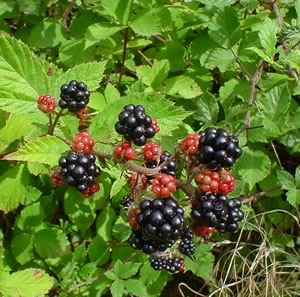
Rubus is a large and diverse genus of flowering plants in the rose family, Rosaceae, subfamily Rosoideae, with 250–700 species.

Central Europe is the region comprising the central part of Europe. It is said to occupy continuous territory that are otherwise conventionally Western Europe, Southern Europe, and Eastern Europe. The concept of Central Europe is based on a common historical, social and cultural identity. Central Europe is going through a phase of "strategic awakening", with initiatives such as the CEI, Centrope and the Visegrád Four. While the region's economy shows high disparities with regard to income, all Central European countries are listed by the Human Development Index as very highly developed.





